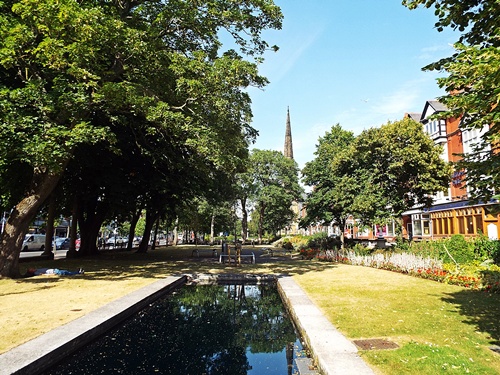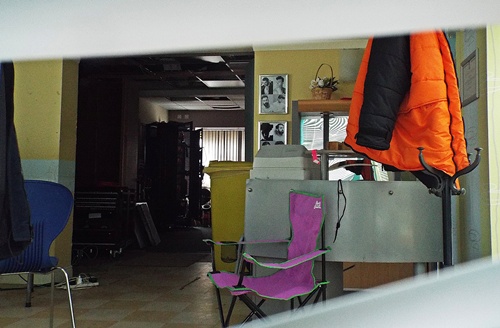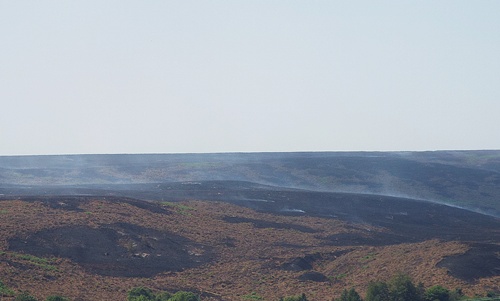Never having got round to writing about it until now – sometimes life and other things have a habit of getting in the way – a very warm and sunny day in mid May saw me taking Sophie and Poppie for a walk to Hall i’ th’ Wood museum via a route which I hadn’t been along for quite some time. Parked all morning in full sun outside the house my van had become like an oven by lunch time so I drove a couple of streets away to an avenue where I could leave it in the shade of several overhanging trees for the rest of the day and my walk started from there.
Crossing the nearby main road I went down a side road and past the lower playing field of the secondary school where I worked several years ago – surrounded by trees and grass banks it looked more like a country area rather than a suburban school playing field and I thought it worthy of a quick photo. From there I went past a couple of blocks of really nice detached and semi-detached houses with well kept gardens blooming with lovely flowers – I’m not a gardener by any means but I do like to see and appreciate other people’s colourful gardens when I pass them.




The side road took me round a corner to another minor road where I came to the Bank Top community garden and Bank Top Brewery. The original Bank Top village was created in 1884 by the Ashworth family who owned the nearby New Eagley Mills (demolished in 1985), to provide quality housing and amenities for their employees. Original buildings included a school house, chapel, library and social club, and though over the years a couple of large modern housing estates have taken over the area there are still several terraced rows of stone cottages remaining. The original Bank Top tennis courts and pavilion were created in 1923 and for seventy years the club had one of the town’s most successful tennis teams, but sadly declining membership numbers and increasing costs for the maintenance of the courts and pavilion finally led to the demise of the club.
Although the tennis courts were abandoned and left to go to rack and ruin the Grade ll listed pavilion was taken over in 1995 by the newly-founded Bank Top micro brewery, which currently produces nine different beers totalling 22,000 pints per week using brewing methods from more than a hundred years ago. In 2004 work finally started on the old tennis courts, eventually turning them into a peaceful community garden for the benefit of the area’s residents. I’d never been in the garden before so decided to take a look – it was lovely and quiet and apart from a young man sitting on a bench and throwing a ball for his dog I had the place to myself. Separated from the community garden by various trees and hedges was the pavilion itself, set in its own garden which was attractive enough to justify taking a couple of photos.


Opposite the pavilion garden was a row of stone cottages and my walk took me round the end of the row and onto an unadopted lane. There was nothing special about the lane, just the tall back fences of some nearby bungalows on one side and a motley collection of private garages looking a bit worse for wear on the other side; these were followed by a heavily wooded area with a steep bank leading down to the nearby Eagley Brook, then the lane ended at the private land belonging to Yew Tree Cottage – which was actually a large detached house with several bedrooms – and a great view of the countryside across the river. A footpath took me past the side garden of the house and through a very pleasant tree-shaded area to another section of the river crossed by a concrete bridge with metal railings, then up a short steep hill I came to an equally steep cobbled lane.

On the lane I had a choice of left or right – I went left first and a narrow path took me through a small wooded area at the back of Hall i’ th’ Wood museum and brought me out at one end of the hall’s parkland. Working my way round to the left I came to the long garden in front of the hall then back onto the cobbled lane and the gates of the hall itself. A small group of people from the local history society were sitting at a table outside the entrance and when I mentioned that I would have to go back on another day without the dogs if I wanted to look round inside one of them very kindly offered to keep an eye on Sophie and Poppie for me if I wanted to go in then – it was an offer I wasn’t going to refuse but I took so many photos while I was in there that I’m going to save them for another post.

With my exploration of the museum over I retrieved the dogs and thanked the lovely lady who had been looking after them, then went back down the cobbled lane and continued past where I could have turned right earlier on. It wasn’t long before the lane itself turned into a rough and rocky narrow track which ran past the high stone wall of some nearby business premises and eventually I emerged near another section of the river and the entrance to a local steel distributors, where another cobbled lane took me up onto a section of the main A58 ‘ring road’ round the northern outskirts of town.


Just after I emerged onto the main road I came to Watermillock, a huge one-time gentleman’s country house set in extensive grounds. Constructed between 1882 and 1886 for Thomas Thwaites, one half of Eden and Thwaites bleachworks owners, it was subsequently inhabited by local mill owner T M Hesketh and his family, then after ending its days as a private residence it became a military hospital in WW1, run by the Red Cross for pilots with horrific burns and other serious injuries. In 1937 the house was used as a hostel for refugee children evacuated from Bilbao during the Spanish Civil War, though they only stayed for about a year before going back home to Spain.
In subsequent years Watermillock became an old people’s home, and though I’m sure I can remember that at sometime during my childhood years it also acted as a subsidiary to the local hospitals’ laundry I can’t find any reference to that. It stayed as an old people’s home into the 1990s when it was finally closed, and eventually it was converted by Banks’s Brewery into a restaurant with function rooms, though for the last few years it’s been a Toby Carvery.

From Watermillock I walked a short distance along the main road then turned off onto a short quiet avenue of modern Georgian-style houses; the avenue ended in a cul-de-sac with a grassy area at the end and just beyond it was a detached house set in quite a large garden. It looked a bit of a mish-mash of a place but it was attractive enough to warrant a photo so I took what was to be the last one of my walk.
At the side of the house a dirt track led past a few allotments and from there it was just a matter of zig-zagging through a few side streets until I reached home. It had been a good walk with a very interesting time spent looking round Hall i’th’ Wood itself but now it was time for the three of us to have a cool drink and relax for a while.








































































































































